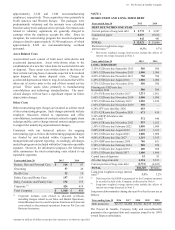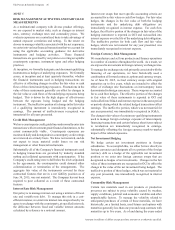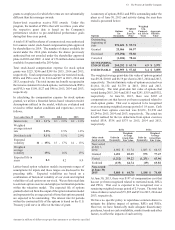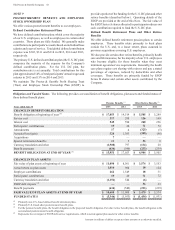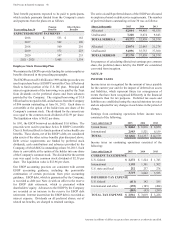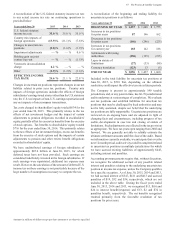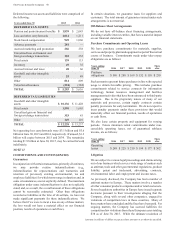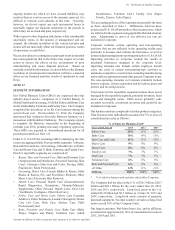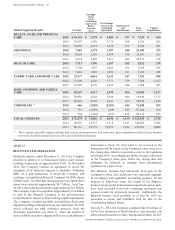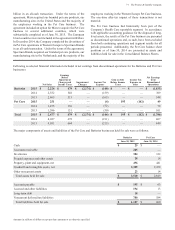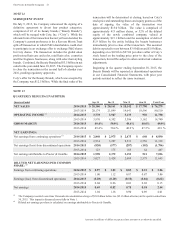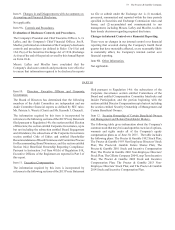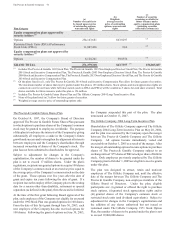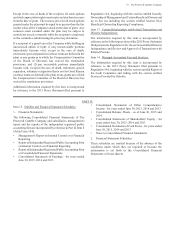Proctor and Gamble 2015 Annual Report Download - page 67
Download and view the complete annual report
Please find page 67 of the 2015 Proctor and Gamble annual report below. You can navigate through the pages in the report by either clicking on the pages listed below, or by using the keyword search tool below to find specific information within the annual report.
65 The Procter & Gamble Company
Amounts in millions of dollars except per share amounts or as otherwise specified.
Our target asset allocation for the year ended June 30, 2015, and actual asset allocation by asset category as of June 30, 2015 and
2014, were as follows:
Target Asset Allocation Actual Asset Allocation at une 0
Pension Benefits
Other Retiree
Benefits
Pension Benefits Other Retiree Benefits
Asset Categor 2015 2014 2015 2014
Cash 2 2 2 1 1 1
Debt securities 51 50 51 5 6
Equity securities 4 95 4 48 94 93
TOTAL 100 100 100 100 100 100
The following tables set forth the fair value of the Company's plan assets as of June 30, 2015 and 2014 segregated by level within
the fair value hierarchy (refer to Note 5 for further discussion on the fair value hierarchy and fair value principles). Common
collective funds are valued using the net asset value reported by the managers of the funds and as supported by the unit prices of
actual purchase and sale transactions. Company stock listed as Level 2 in the hierarchy represents preferred shares which are
valued based on the value of Company common stock. The majority of our Level 3 pension assets are insurance contracts. Their
fair values are based on their cash equivalent or models that project future cash flows and discount the future amounts to a present
value using market-based observable inputs, including credit risk and interest rate curves.
Pension Benefits
Leel 1 Leel 2 Leel Total
Years ended une 0 2015 2014 2015 2014 2015 2014 2015 2014
ASSETS AT FAIR VALUE
Cash and cash equivalents 154 $ 79 112 $
$
2 $ 79
Collective fund - equity 5,054 5,336 5,054 5,336
Collective fund - fixed income 5,12 5,539 5,12 5,539
Other 45119 139 12 144
TOTAL ASSETS AT FAIR VALUE 15 $ 84 10,2 $ 10,875 119 $ 139 10,05 $ 11,098
Other Retiree Benefits
Leel 1 Leel 2 Leel Total
Years ended une 0 2015 2014 2015 2014 2015 2014 2015 2014
ASSETS AT FAIR VALUE
Cash and cash equivalents $ 30
$
$
$ 30
Company stock ,29 3,304 ,29 3,304
Common collective fund - equity 1 18 1 18
Common collective fund - fixed
income 1 217 1 217
Other 55
TOTAL ASSETS AT FAIR VALUE $ 30 ,44 $ 3,539
$5
,40 $ 3,574
There was no significant activity within the Level 3 pension and other retiree benefits plan assets during the years presented.
s losManagement's best estimate of cash requirements
and discretionary contributions for the defined benefit
retirement plans and other retiree benefit plans for the year
ending June 30, 2016, is $215 and $34, respectively. For the
defined benefit retirement plans, this is comprised of $96 in
expected benefit payments from the Company directly to
participants of unfunded plans and $119 of expected
contributions to funded plans. For other retiree benefit plans,
this is comprised of $27 in expected benefit payments from the
Company directly to participants of unfunded plans and $7 of
expected contributions to funded plans. Expected
contributions are dependent on many variables, including the
variability of the market value of the plan assets as compared
to the benefit obligation and other market or regulatory
conditions. In addition, we take into consideration our business
investment opportunities and resulting cash requirements.
Accordingly, actual funding may differ significantly from
current estimates.


